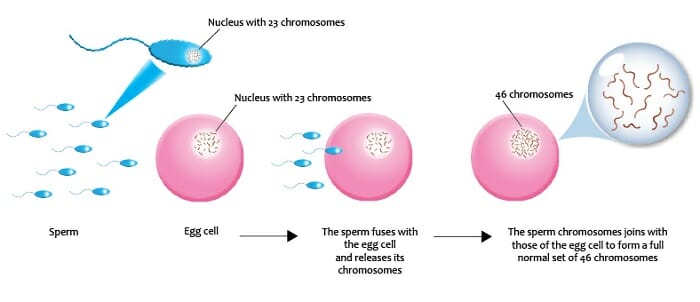Sexual and Asexual Reproductive System – Definition, Diagrams, Difference
Reproduction is the process through which an organism reproduces its own offspring. As a result, their species does not face extinction.
Types of Reproduction
Reproduction can occur with the cooperation of a single or two parents. Reproduction is divided into two types.
- Asexual reproduction: A process where a single parent divides and reproduces its offspring.
- Sexual reproduction: A process in which two parents collaborate to produce their offspring.

What is Asexual Reproduction?
Asexual reproduction is a kind of reproduction in which a single parent gives birth to a new child. The newly produced are genetically and physically identical to one another.
Both multicellular and unicellular species exhibit asexual reproduction. There will be no gamete fusion or change in the number of chromosomes as a result of this operation. It will inherit the same genes as the parent, except for a few circumstances where a rare mutation may develop.
Types of Asexual Reproduction
Here are different types of asexual reproduction:
Binary Fission: The single-celled organism splits into two halves. Each half rapidly develops into an adult. Example Amoeba and Paramecium.
Fragmentation: Asexual reproduction occurs in certain multicellular organisms, such as Spirogyra, by fragmentation. The parent body splits pieces here, which grow into a new person.
Budding: Some organisms reproduce by budding, which occurs when buds form on the parent body. Each fresh bud gives rise to a new organism. Hydra is one example of this.
Vegetative Propagation: This type of asexual reproduction is commonly seen in plants, where a sprout can develop. This shoot, in turn, can develop into a new creature.
Sporogenesis: Spores are reproductive cells produced by some organisms. The spores develop into new creatures. The spores might be transported by wind or by other animals.
Examples of Asexual Reproduction
Here are some examples of asexual reproduction:
- Bacterium undergoes binary fission, in which the cell and nucleus divide into two.
- Mud worms and blackworms reproduce through fragmentation.
- Hydras reproduce by budding.
- Parthenogenesis occurs in organisms such as copperheads.
- Vegetative propagation can be used to grow sugarcane.
Characteristics of Asexual Reproduction
- There is a single parent involved.
- There is no fertilization or gamete formation.
- This replication procedure takes a relatively short period.
- The creatures proliferate and develop at a fast pace.
- The offspring are genetically identical.
Asexual Reproduction in Plants
In multicellular organisms, fragmentation is seen, where, as a process, pieces in small sizes break off and they grow into new organisms. There is also another method that features budding. This produces a fully new organism but stays attached to the parent or original body, or forms out of the parent body. In all these developments, we observe that there is a binding feature, the offspring or the organism is the direct clone of the parent.
For transferring the genes to the later generations in species, asexual reproduction augurs very well. Since it is asexual, there is no scope for alteration or dilution of genes of the original body, by another partner. Asexual production in plants demonstrates this aspect and is also faster asexual reproduction, than sexual reproduction.
Advantages and Disadvantages of Asexual Reproduction
| Advantages | Disadvantages |
| Mates are not necessary | They are incapable of adapting to changing conditions |
| The reproduction procedure is quick | A single environmental change is enough to wipe out the entire species |
| Can produce more organisms in less time | The organisms’ diversity is minimal |
| Same genetics are passed to successive generations | All negative mutations are also passed down through generations |
What is Sexual Reproduction?
Sexual reproduction is a natural method of reproduction in humans, animals, and the vast majority of plants. This method of reproduction is more difficult and time-consuming than asexual reproduction. Also, sexual reproduction provides the advantage of diversity as the new generation is unique to its parents. Sexual reproduction is a series of activities that may be classified into three stages: pre-fertilization, fertilization, and post-fertilization.

Sexual Reproduction – Complexity
It has to be noted that sexual reproduction involves a lot more complexity and depth when compared to asexual reproduction. This is because it features the production of gametes that have half the number of chromosomes compared to the rest of the cells in an organism. There is a process called meiosis that produces haploid cells from diploid cells. Then we see crossing over happening and the genes recombination. Switching from chromosomes to chromosomes ideally ensures that the genes remain active among the given population. Then there are several other determining factors in sexual reproduction, such as the gestation period where the foetus needs a certain time to fully develop internally like the womb of the mother organism, or externally like being born out of an egg.
Stages of Sexual Reproduction
Pre-Fertilization
This stage encompasses the events that occur before fertilization. At this stage, two processes occur: gamete production (gametogenesis) and gamete transfer. Gametes are naturally haploid sex cells that differ between men and women. The male gamete is referred to as sperm, whereas the female gamete is referred to as an ovum or egg. Every organism produces gametes within specialized structures. Because female gametes are immobile, male gametes must be transferred to fertilize. Pollination achieves this in plants. Unisexual animals transfer gametes through sexual interaction.
Fertilization
Fertilisation or syngamy, happens when haploid male and female gametes unite to form a zygote. This can happen outside the body, which is known as external fertilization, or inside the body, which is known as internal fertilization.
Post-Fertilization
Post-fertilization a diploid zygote will be formed. The zygote splits and develops into an embryo by mitotic division. This is known as embryogenesis. Cell differentiation and modification occur throughout development. The development of a zygote is determined by the organism and its life cycle.
Animals are categorized as oviparous or viviparous based on whether the zygote develops outside or within the body. In angiosperms, the zygote grows into the ovary, which then becomes the fruit, and the ovules mature into seeds.
Sexual Reproduction in Plants
Reproduction in plants takes place sexually as well as asexually. However, it is interesting to note that most of the flowering plants feature sexual reproduction. The reproductive part of a plant is a flower and both male and female gametes are produced by flowers. Thus, sexual reproduction in any plant happens inside the flower.
The four major parts of a flower are:
- Petals
- Sepals
- Pistil/Carpel (female reproductive part)
- Stamen (male reproductive part)
Stamen or the male reproductive part constitutes an anther that stores pollen and filament that acts as a support to the anther.
- The anther is a sac-like structure that produces and stores pollen.
- The filament supports the anther.
The pistil or the female reproductive part is made up of the top-most part stigma, a long tube called style, and the ovary that stores ovules and where seeds are formed.
Pollination and Fertilization
For the formation of a zygote, male gametes in pollen grains will with the egg in the ovule through pollination. Pollination is the process where pollen grains are transferred from the anther to the stigma. There are two types of pollination based on the landing of the pollen:
- Self-pollination is where pollen transfers between the anther and stigma of the same flower.
- Cross-pollination is where the pollen transfer happens between the anther and the stigma of different flowers of the same plant or different plants of the same species.
Differences Between Sexual and Asexual Reproduction
The main difference between asexual and sexual reproduction is the fusing of male and female gametes that occurs during sexual reproduction, in asexual reproduction, there is no requirement of male and female and no fusion of gametes.
|
Basis for Comparison |
Asexual Reproduction |
Sexual Reproduction |
| Occurs in | Asexual reproduction is observed in primitive living organisms. | Sexual reproduction is a natural method in humans, animals, and plants. |
| Process | Asexual reproduction is a single-parental process that produces a new child. | Sexual reproduction is typically a bi-parental process involving two separate parents. |
| Involvement of gametes | Asexual reproduction does not include gametes. | Sexual reproduction requires gametes. |
| Fertilization | Fertilization does not occur during sexual reproduction. | The sexual reproduction of males and females results in fertilization. |
| Diversity | Asexual reproduction produces no genetic diversity. | Sexual reproduction is critical for establishing genetic diversity within a community. |
Final Notes
Learn more in detail about Asexual and sexual reproduction, and other related topics with Tutoroot‘s 1:1 personalized tutoring session.
FAQs
Define Sexual reproduction
Sexual reproduction is a natural method of reproduction in humans, animals, and the vast majority of plants. This method of reproduction is more difficult and time-consuming than asexual reproduction. Also, sexual reproduction provides the advantage of diversity as the new generation is unique to its parents. Sexual reproduction is a series of activities that may be classified into three stages: pre-fertilization, fertilization, and post-fertilization.
Define Asexual Reproduction
Asexual reproduction is a kind of reproduction in which a single parent gives birth to a new child. The newly produced are genetically and physically identical to one another.
Both multicellular and unicellular species exhibit asexual reproduction. There will be no gamete fusion or change in the number of chromosomes as a result of this operation. It will inherit the same genes as the parent, except for a few circumstances where a rare mutation may develop.
Give examples of asexual reproduction
The Examples of asexual reproduction are given below,
- Bacterium undergoes binary fission, in which the cell and nucleus divide into two.
- Mud worms and blackworms reproduce through fragmentation.
- Hydras reproduce by budding.
- Parthenogenesis occurs in organisms such as copperheads.
- Vegetative propagation can be used to grow sugarcane.
Give examples of sexual reproduction
The best examples of sexual reproduction are Animals and plants
What is the advantage of sexual reproduction
The advantages of sexual reproduction are given below,
- Increase in genetic variability
- Higher survival chances of species is evident
- Formation of new species is possible
- Evolution

